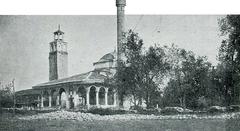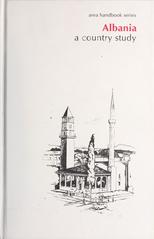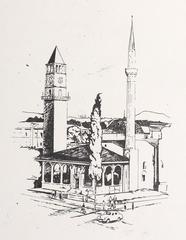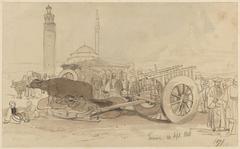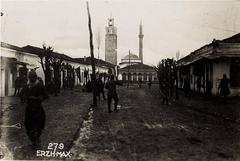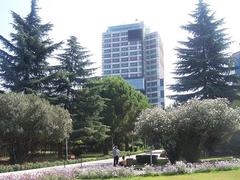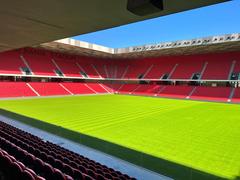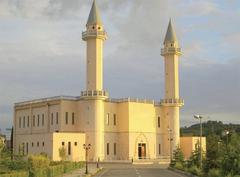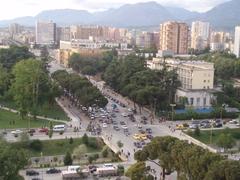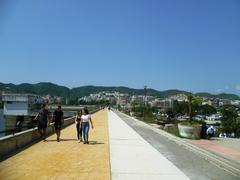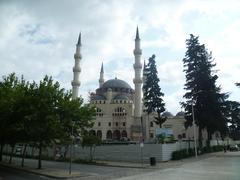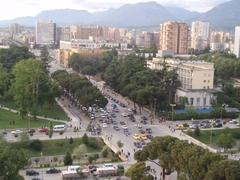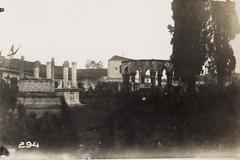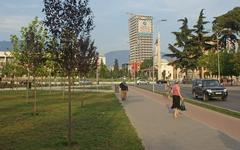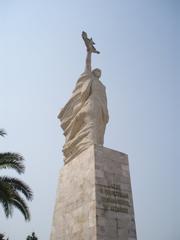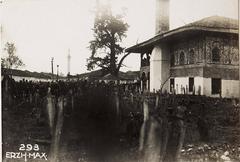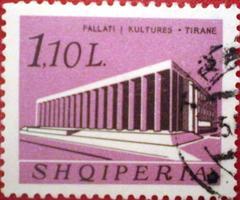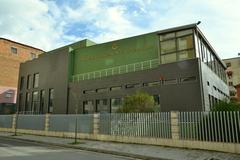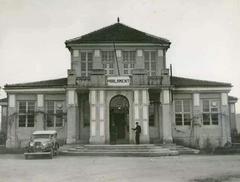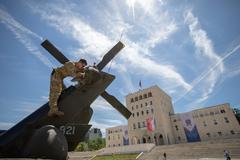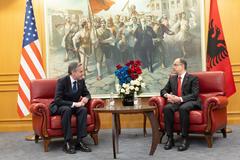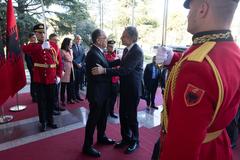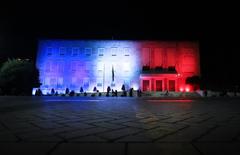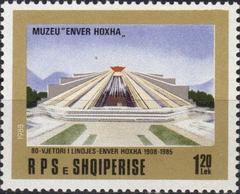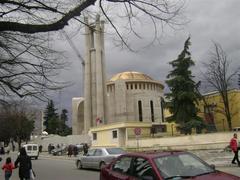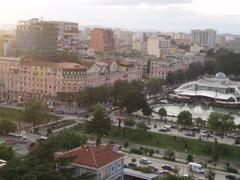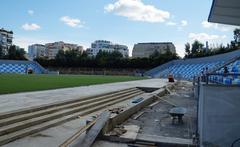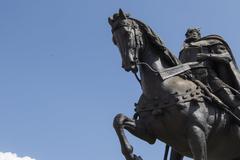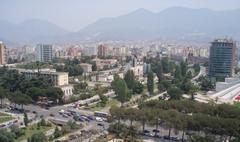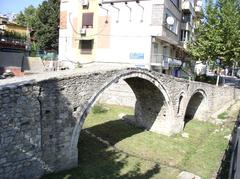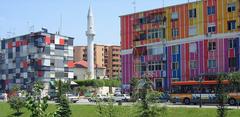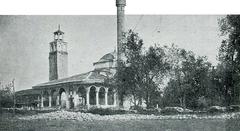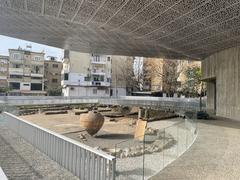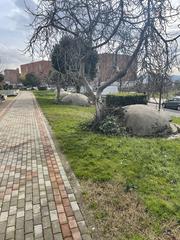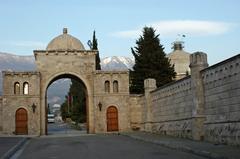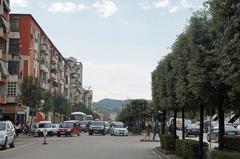
Et Hem Bey Mosque Tirana Visiting Hours Tickets and Historical Significance
Date: 14/06/2025
Introduction to Et Hem Bey Mosque Tirana including its history and cultural importance
Nestled in the vibrant heart of Tirana, the Et’Hem Bey Mosque stands as a distinguished symbol of Albania’s rich Ottoman heritage and cultural resilience. Constructed between the late 18th and early 19th centuries, this mosque is renowned not only for its exquisite frescoes and unique architectural blend of Ottoman and local artistic traditions but also for its profound historical and spiritual significance. Visitors to the mosque encounter a rare harmony of intricate naturalistic frescoes depicting trees, waterfalls, and bridges—an uncommon motif in Islamic religious art—that invites reflection and awe.
Beyond its architectural grandeur, the mosque has played a pivotal role in Tirana’s religious, cultural, and civic life, surviving tumultuous periods including the communist ban on religious practices. Its peaceful reopening in 1991 marked a turning point for religious freedom in Albania, underscoring the mosque’s status as a living monument of tolerance and national identity. Today, the Et’Hem Bey Mosque welcomes visitors daily, offering free admission and guided tours that illuminate its rich history, artistic heritage, and ongoing cultural importance.
Located adjacent to Skanderbeg Square and notable landmarks such as the Clock Tower and National History Museum, the mosque is easily accessible and forms a central part of Tirana’s historical landscape. Whether you are a history enthusiast, architecture lover, or cultural traveler, this comprehensive guide will provide you with all the essential information for a memorable visit, including visiting hours, accessibility, travel tips, and nearby attractions (visit-tirana.com; livetheworld.com; matias-travel.com).
Contents including visiting hours ticket information guided tours nearby attractions and FAQs
- Introduction: A Historical Gem in the Heart of Tirana
- Ottoman Foundations and Construction Timeline
- Architectural Features and Artistic Flourishes
- Historical Role in Tirana’s Urban and Religious Life
- Survival Through the Communist Era
- The 1991 Reopening and Symbol of Religious Freedom
- Visiting Hours and Admission
- Accessibility and Visitor Tips
- Nearby Attractions
- Cultural Recognition and Preservation
- Frequently Asked Questions (FAQ)
- Conclusion
Introduction
Nestled in the heart of Tirana, the Et’Hem Bey Mosque is one of Albania’s most treasured historical sites, offering visitors a glimpse into the city’s rich Ottoman heritage. Known for its exquisite frescoes, architectural beauty, and profound cultural significance, the mosque not only serves as a place of worship but also as a symbol of religious tolerance and resilience in Albania. Whether you are a history enthusiast, an architecture lover, or a traveler seeking to explore Tirana’s cultural landmarks, this guide covers everything you need to know about visiting the Et’Hem Bey Mosque, including visiting hours, ticket information, and travel tips.
Ottoman Foundations and Construction Timeline
The Et’Hem Bey Mosque stands as a testament to Tirana’s Ottoman heritage, with its origins tracing back to the late 18th century. The mosque’s foundation was laid by Molla Bey in 1208 AH (1794 AD), a prominent figure in Tirana’s early urban development. Molla Bey oversaw the construction of the mosque’s dome but passed away in 1223 AH (1807 AD), leaving the project incomplete. His son, Haxhi Et’hem Bey, continued the work, completing the main structure, including the minaret, roof, entrance, and the mosque’s distinctive interior decorations and paintings by 1236 AH (1821 AD). The final touches, particularly the exterior frescoes and decorative elements, were finished two years later in 1238 AH (1823 AD) (visit-tirana.com).
The mosque was part of a larger architectural complex that formed the historic core of Tirana, closely linked with the adjacent Clock Tower, another iconic Ottoman-era structure. This ensemble not only defined the city’s skyline but also established the area as a focal point for religious, social, and civic life (livetheworld.com).
Architectural Features and Artistic Flourishes
Et’Hem Bey Mosque is celebrated for its unique blend of Ottoman architectural principles and local artistic traditions. The mosque’s prayer hall is characterized by a squared plan, topped with a semi-spherical dome that is notably devoid of windows, creating a serene and contemplative interior atmosphere. Surrounding the north side is a portico, providing a shaded space for worshippers and visitors alike.
One of the mosque’s most remarkable features is its intricate frescoes, which adorn both the exterior and the portico. These murals are exceptional within Islamic art, as they depict naturalistic scenes—trees, waterfalls, bridges, and landscapes—rather than the more common geometric or calligraphic motifs. The frescoes, while not strictly realistic, evoke a sense of imagination and tranquility, transporting visitors into a world of beauty and reflection (matias-travel.com). The minaret, completed by Haxhi Et’hem Bey, rises elegantly above the mosque, serving as both a visual landmark and a symbol of the city’s Islamic heritage.
Historical Role in Tirana’s Urban and Religious Life
From its completion in the early 19th century, the Et’Hem Bey Mosque quickly became a central institution in Tirana. As one of the few surviving mosques from the city’s Ottoman period, it played a pivotal role in shaping the religious and cultural identity of the local Muslim community. The mosque was not only a place of worship but also a gathering point for civic discourse and community events, reflecting the intertwined nature of religious and public life in Ottoman Albania (thefreelibrary.com).
The mosque’s location in the heart of Tirana, adjacent to Skanderbeg Square and the Clock Tower, further cemented its status as a cultural and historical anchor. Over the centuries, it witnessed the city’s transformation from a modest Ottoman town to the vibrant capital of modern Albania.
Survival Through the Communist Era
The 20th century brought profound challenges to religious institutions in Albania. Following World War II, the establishment of the Socialist People’s Republic of Albania under Enver Hoxha led to an aggressive campaign against religion. By the late 1960s, Albania declared itself the world’s first atheist state, and all religious practices were banned. The Et’Hem Bey Mosque, along with other places of worship, was closed and fell into disrepair during this period (livetheworld.com).
Despite these hardships, the mosque’s architectural integrity and artistic treasures were preserved, albeit in a state of neglect. Its survival through decades of enforced secularism is a testament to the resilience of Albania’s cultural heritage and the enduring significance of the site for the local community.
The 1991 Reopening and Symbol of Religious Freedom
A defining moment in the mosque’s modern history occurred on January 18, 1991. As communist rule in Albania began to wane, approximately 10,000 people gathered at the Et’Hem Bey Mosque, carrying Albanian flags and demanding the restoration of religious freedom. In a peaceful yet powerful act of civil disobedience, they entered the mosque and held prayers, defying the authorities’ ban on religious gatherings. This event is widely regarded as a turning point in Albania’s transition from totalitarianism to democracy and the rebirth of religious life in the country (matias-travel.com; livetheworld.com).
The reopening of the mosque not only restored its function as a place of worship but also elevated it as a national symbol of resilience, tolerance, and the right to religious expression. The event is commemorated as a milestone in Albania’s journey toward pluralism and coexistence.
Visiting Hours and Admission
Visitors planning to explore this historic Tirana landmark will find the Et’Hem Bey Mosque open daily from 9:00 AM to 5:00 PM. Admission is free of charge, reflecting the mosque’s role as a welcoming cultural and religious site. Visitors are kindly asked to dress modestly and remove their shoes before entering the prayer hall, in respect of the mosque’s sacred nature.
Accessibility and Visitor Tips
The mosque is wheelchair accessible via the main entrance, and the site offers shaded areas in the portico for rest. The best time to visit is during the spring and autumn months when the weather in Tirana is mild, allowing for comfortable exploration of both the mosque and nearby attractions.
Guided tours are available through local tour operators and some visitor centers in Tirana, providing in-depth historical context and architectural insights. Photography is permitted in designated areas, with the mosque’s exterior frescoes and minaret offering particularly picturesque spots.
Nearby Attractions
Located adjacent to Skanderbeg Square, the Et’Hem Bey Mosque is close to several other notable Tirana historical sites, including the Clock Tower, the National History Museum, and the Palace of Culture. Visitors can easily combine their mosque visit with a walking tour of Tirana’s vibrant city center.
Cultural Recognition and Preservation
In recognition of its historical, architectural, and cultural value, the Et’Hem Bey Mosque was declared a Cultural Monument of the First Category in 1948 (visit-tirana.com). This designation ensures the mosque’s protection and preservation for future generations, highlighting its importance not only to the Muslim community but to all Albanians as a shared heritage site.
Conclusion
The Et’Hem Bey Mosque stands as a shining jewel among Tirana historical sites, offering visitors a unique blend of history, art, and spiritual significance. Its rich past, stunning frescoes, and role in Albania’s journey towards religious freedom make it a must-visit destination. Whether you are visiting for worship, education, or cultural enrichment, the mosque invites you to experience a living monument that embodies the spirit of Tirana and its people.
Frequently Asked Questions (FAQ)
Q: What are the Et’Hem Bey Mosque visiting hours? A: The mosque is open daily from 9:00 AM to 5:00 PM.
Q: Is there an entrance fee or ticket required? A: No, entrance to the mosque is free of charge.
Q: Are guided tours available? A: Yes, guided tours can be arranged through local tour operators in Tirana.
Q: Is the mosque accessible for visitors with mobility challenges? A: Yes, the mosque is wheelchair accessible.
Q: Are photography and videography allowed inside the mosque? A: Photography is allowed in designated areas, especially the exterior frescoes and minaret.
Call to Action
Plan your visit to the Et’Hem Bey Mosque today and immerse yourself in Tirana’s rich cultural heritage. Download the Audiala app for easy access to guided tours, maps of Tirana historical sites, and up-to-date visitor information. Don’t forget to explore our related posts on other must-see landmarks in Tirana and follow us on social media for the latest travel tips and cultural insights.
Et’Hem Bey Mosque Tirana: Visiting Hours, Tickets, and Architectural Highlights
Introduction
The Et’Hem Bey Mosque, one of Tirana’s most cherished historical sites, stands as a remarkable example of late Ottoman religious architecture in Albania. Beyond its architectural grandeur and exquisite frescoes, the mosque offers visitors a glimpse into the city’s cultural and spiritual heritage. This article covers everything you need to know about visiting the Et’Hem Bey Mosque, including visiting hours, tickets, accessibility, and detailed architectural highlights.
Visiting Hours and Tickets
The Et’Hem Bey Mosque is open to visitors daily outside of prayer times, generally from 9:00 AM to 6:00 PM. It is closed during the five daily Islamic prayer times to respect worshippers. Admission to the mosque is free of charge, making it an accessible attraction for all visitors interested in exploring Tirana historical sites.
Visitors are advised to check the official Tirana tourism website or the mosque’s local information boards for any changes in visiting hours or special events.
Accessibility and Visitor Guidelines
The mosque is located centrally on Skanderbeg Square, easily accessible by foot or public transportation. While the entrance area is wheelchair accessible, some parts of the mosque have steps, so visitors with mobility issues may want to plan accordingly.
Visitors must dress modestly: shoulders and knees should be covered, and women are encouraged to wear a headscarf. Shoes must be removed before entering the prayer hall. Photography is generally allowed, but the use of flash is discouraged to protect the delicate frescoes.
Guided Tours and Special Events
Guided tours are available and highly recommended for those interested in a deeper understanding of the mosque’s history, architecture, and cultural significance. These tours can often be booked through local tour operators or the Tirana tourism office.
The mosque occasionally hosts religious and cultural events, especially during important Islamic holidays. Visitors during these times can experience the mosque’s vibrant community atmosphere but should check schedules in advance.
Architectural Highlights
Exterior Design and Layout
The Et’Hem Bey Mosque, built between 1791 and 1821, is a quintessential example of late Ottoman religious architecture. Situated prominently on Skanderbeg Square, its nearly square plan measures about 18 meters on each side. The mosque’s single elegant dome, covered in lead and rising about 15 meters high atop an octagonal drum, creates a distinctive silhouette against Tirana’s skyline.
A slender minaret stands at approximately 35 meters, adorned with geometric motifs and a single balcony (şerefe) traditionally used for the call to prayer. The mosque’s entrance features a portico supported by ten marble columns with intricately carved capitals, topped by three smaller red-tiled domes decorated with painted floral and geometric patterns.
Interior Decoration and Artistic Elements
The mosque’s interior is renowned for its elaborate frescoes, which uniquely incorporate landscape scenes such as trees, waterfalls, bridges, and imaginary cities—an uncommon feature in Islamic religious art. These colorful frescoes, executed in vibrant blues, greens, reds, and golds, invite contemplation and highlight a blend of Ottoman and local artistic traditions.
The finely carved and painted mihrab and the delicately carved wooden minbar serve as focal points within the prayer hall. The central dome’s medallion boasts intricate calligraphy and floral motifs, harmonizing with the decorated pendentives and arches.
Materials and Construction Techniques
Constructed with finely cut limestone and sandstone, the mosque’s structural elements emphasize durability and aesthetic appeal. Marble columns and decorative elements reflect the patrons’ wealth. Traditional Ottoman techniques were used for the dome and portico roofs, combining wooden frameworks with lead sheets and red tiles. Frescoes are painted with natural pigments on plastered walls using the fresco secco technique.
Symbolism and Cultural Influences
The mosque’s design synthesizes Ottoman, Albanian, and Balkan influences. Its geometric and floral motifs symbolize the infinite nature of creation, while the rare inclusion of landscape frescoes reflects a dialogue between Islamic art and local Albanian culture. The mosque’s orientation towards Mecca is carefully maintained with the mihrab on the southern wall.
Restoration and Preservation Efforts
Throughout its history, the Et’Hem Bey Mosque has undergone several restorations. During Albania’s communist era, it was closed for worship and used as a museum, which preserved its interior frescoes. After communism, restoration efforts focused on cleaning and stabilizing the frescoes, repairing structural elements, and preserving the mosque’s unique features. Today, it is protected as a cultural heritage site with ongoing maintenance.
Visitor Experience and Accessibility
Located on Skanderbeg Square near other landmarks such as the National History Museum and the Clock Tower, the mosque is easily accessible. Visitors should dress modestly and remove shoes before entering. Photography without flash is permitted, and guided tours provide valuable historical context.
FAQ
Q: Are there any entrance fees for the Et’Hem Bey Mosque? A: No, admission is free.
Q: What are the visiting hours? A: Typically, 9:00 AM to 6:00 PM daily, closed during prayer times.
Q: Is the mosque wheelchair accessible? A: The entrance is wheelchair accessible, but some areas have steps.
Q: Are guided tours available? A: Yes, guided tours can be booked through local operators or the tourism office.
Q: Is photography allowed inside the mosque? A: Yes, but without flash to protect the frescoes.
Q: What is the dress code for visitors? A: Modest clothing covering shoulders and knees is required; women are encouraged to wear headscarves.
Conclusion
The Et’Hem Bey Mosque is not only a stunning monument of Ottoman architecture but also a vibrant cultural symbol in Tirana. Whether you are an architecture enthusiast, history buff, or casual traveler, its harmonious design, vibrant frescoes, and rich history make it a must-visit Tirana historical site.
Plan your visit today to experience this unique blend of art, spirituality, and heritage in the heart of Albania’s capital.
Call to Action
For more detailed travel tips and updates on visiting the Et’Hem Bey Mosque and other Tirana landmarks, download the Audiala app. Explore related articles on Tirana’s cultural sites and follow us on social media to stay informed about upcoming events and guided tours.
Et’Hem Bey Mosque Visiting Hours, Tickets & History | Top Tirana Historical Site
Discover the Et’Hem Bey Mosque: A Must-Visit Historical and Cultural Landmark in Tirana
Located in the heart of Tirana, the Et’Hem Bey Mosque is not only one of the city’s most important religious sites but also a captivating symbol of Albania’s rich cultural heritage. This guide covers everything you need to know about visiting the mosque, including its history, visiting hours, ticket information, travel tips, and nearby attractions.
Visiting Hours and Ticket Information
The Et’Hem Bey Mosque is open to visitors daily, with typical visiting hours from 9:00 AM to 6:00 PM. Please note that access is restricted during prayer times, so plan your visit accordingly to experience both the mosque’s architectural beauty and its spiritual atmosphere.
Admission: Entry to the mosque is free of charge, reflecting its status as an active place of worship and a cultural monument. However, donations are welcome to support maintenance and preservation efforts.
Guided Tours: Guided tours are available outside of prayer hours and can be booked through local tour operators or at the Tirana Tourism Information Center. These tours provide insightful details about the mosque’s architecture, history, and significance.
Accessibility: The mosque is wheelchair accessible, with ramps at the main entrance, ensuring all visitors can enjoy this historic site.
Historical and Cultural Significance
The Et’Hem Bey Mosque, built in the early 19th century, survived Albania’s communist regime, during which religious practices were banned. Its reopening in 1991 marked a turning point for religious freedom in the country, drawing thousands of Albanians in a peaceful demonstration. Today, it stands as a testament to endurance, tolerance, and pluralism.
The mosque is also an architectural gem, featuring Ottoman design elements such as a slender minaret, domed prayer hall, and unique frescoes depicting natural scenes—uncommon in Islamic art. Inside, visitors can admire intricate calligraphy and geometric patterns that blend Ottoman, Byzantine, and Romanesque influences.
Travel Tips and Visitor Etiquette
- Dress Code: Visitors should dress modestly—shoulders and knees covered. Women are not required to cover their hair but doing so is appreciated.
- Shoes: Shoes must be removed before entering the prayer hall.
- Photography: Photography is allowed in most areas; however, avoid taking photos during prayer times or of worshippers without permission.
- Best Time to Visit: Early mornings or late afternoons are ideal to avoid crowds and experience a peaceful ambiance.
Nearby Attractions and Photographic Spots
Situated in Skanderbeg Square, the mosque is surrounded by iconic landmarks:
- Clock Tower of Tirana: Just steps away, offering panoramic views of the city.
- National History Museum: Explore Albania’s extensive history.
- Opera House: A cultural hub for music and arts.
The mosque’s ornate exterior and frescoes make excellent photography subjects, especially in natural light during golden hour.
Frequently Asked Questions (FAQs)
Q: Is there an entrance fee to visit the Et’Hem Bey Mosque? A: No, admission is free.
Q: What are the visiting hours of the mosque? A: Generally, from 9:00 AM to 6:00 PM, but it closes during prayer times.
Q: Are guided tours available? A: Yes, guided tours can be booked through local providers.
Q: Is the mosque wheelchair accessible? A: Yes, ramps provide access for wheelchair users.
Q: Can non-Muslim visitors enter the mosque? A: Absolutely, the mosque welcomes visitors of all backgrounds outside prayer times.
Plan Your Visit Today!
The Et’Hem Bey Mosque offers a unique blend of spiritual significance, architectural beauty, and historical depth. Whether you’re a history enthusiast, architecture lover, or cultural traveler, this site is a highlight of Tirana.
For the latest updates, guided tour bookings, and travel tips, download the Audiala app—your personalized travel companion for Albania. Follow us on social media for more insights and insider guides to Tirana’s top attractions.
Start your Albanian journey with the Et’Hem Bey Mosque, a living symbol of resilience and harmony at the heart of the capital.
Images of the mosque’s exterior, frescoes, and interior are recommended to enhance this article. Alt text examples: “Et’Hem Bey Mosque exterior view in Tirana,” “Fresco paintings inside Et’Hem Bey Mosque,” and “Visitors removing shoes before entering Et’Hem Bey Mosque prayer hall.”
For directions, see the embedded map below or visit the Tirana Tourism Information Center.
Introduction: A Historical Gem in the Heart of Tirana
Et’Hem Bey Mosque (Xhamia e Et’hem Beut) is one of Tirana’s most treasured historical and cultural landmarks. Built in the late 18th and early 19th centuries, this Ottoman-era mosque is renowned for its exquisite frescoes and architectural beauty. Beyond its religious significance, the mosque symbolizes Albania’s cultural resilience, having survived periods of suppression during the communist era and playing a key role in the country’s return to religious freedom.
Location and Getting There
Located on the southern edge of Skanderbeg Square (Sheshi Skënderbej, 1000 Tirana, Albania; Plus Code: 8RH9+4P Tirana), Et’Hem Bey Mosque is easily accessible on foot from most parts of the city center. It is adjacent to major landmarks including the Clock Tower of Tirana and the National History Museum, making it an essential stop for visitors exploring Tirana’s historical sites.
Public transportation options include several city bus lines stopping near Skanderbeg Square. Taxis are affordable and widely available. Parking around the mosque is limited due to pedestrian zones, so using public transport or walking is recommended.
Opening Hours and Entry
- Visiting Hours: Daily from 5:00 AM to 10:30 PM
- Entry Fee: Free
Visitors can enter the mosque without any ticket purchase, although donations are welcomed to support preservation efforts. It is advisable to check ahead for any schedule changes during religious holidays or special events, as access may be restricted during prayer times.
Accessibility
The mosque is at ground level, with the main prayer hall accessible by a few steps. While no dedicated wheelchair ramp exists, the entrance width allows manageable access with assistance. The surrounding Skanderbeg Square is flat and pedestrian-friendly. Drop-off points are nearby, but dedicated disabled parking is not available. Restroom facilities may have limited accessibility.
Visitor Experience
Atmosphere and Ambience
Et’Hem Bey Mosque offers a tranquil retreat with its serene courtyard and ornately decorated interior. Intricate frescoes depict natural scenes and Ottoman motifs, providing a rich visual experience. The mosque remains an active place of worship, and visitors may observe daily prayers, gaining insight into local religious traditions.
Time Required
Allocate 10–20 minutes to appreciate the architecture and artwork. Visitors interested in attending prayers or quiet reflection may spend up to an hour.
Guided Tours and Special Events
While the mosque does not provide official guided tours, many local tour operators include it in walking tours of Tirana’s historic center. These tours offer engaging historical and cultural commentary enhancing the visit. During major Islamic festivals like Eid, the mosque and Skanderbeg Square host community events, offering a unique cultural experience.
Dress Code and Etiquette
Visitors should observe the following to respect the mosque’s sanctity:
- Dress modestly, covering shoulders and knees.
- Women are encouraged to cover their heads with a scarf inside the prayer hall.
- Remove shoes before entering; shoe racks are available.
- Maintain silence and avoid disruptive behavior.
- Photography is allowed, but seek permission before photographing worshippers or ceremonies; avoid flash photography inside.
- Non-Muslim visitors may be asked to wait outside during the five daily prayers, especially on Fridays and religious holidays.
Facilities and Amenities
- Donation boxes are present for voluntary contributions.
- Basic restrooms are available but may have limited capacity.
- Shaded seating areas in the mosque’s courtyard and portico.
- Numerous cafes, restaurants, and shops nearby, including the Toptani Shopping Center.
Best Times to Visit
- Early morning or late afternoon for quieter visits and optimal lighting for photography.
- Weekdays generally see fewer visitors than weekends or holidays.
- During Islamic festivals, expect lively community celebrations but possible access restrictions.
Safety and Security
The mosque is situated in a well-patrolled, safe area. Visitors should practice standard precautions, such as safeguarding belongings, especially in crowded areas.
Cultural Significance
Et’Hem Bey Mosque is not only a religious site but also a symbol of Albania’s cultural identity and resilience. Its survival through the communist ban on religious practices and its role in the 1991 peaceful demonstration underscore its national importance.
Nearby Attractions
- Clock Tower of Tirana: Offers panoramic city views.
- Skanderbeg Square: Central plaza featuring the Skanderbeg Statue and National History Museum.
- Toptani Shopping Center: For shopping and dining.
- Resurrection of Christ Orthodox Cathedral: Another prominent religious site nearby.
Frequently Asked Questions (FAQ)
Q: Is there an entrance fee to visit Et’Hem Bey Mosque? A: No, entry is free. Donations are appreciated.
Q: What are the mosque’s visiting hours? A: Open daily from 5:00 AM to 10:30 PM.
Q: Are guided tours available inside the mosque? A: The mosque does not offer official tours, but many local tour companies include it in their city tours.
Q: Is the mosque accessible for visitors with disabilities? A: The mosque has steps at the entrance and limited accessibility. Assistance is recommended.
Q: Can I take photographs inside the mosque? A: Yes, but avoid flash photography and always ask permission before photographing worshippers or ceremonies.
Q: What is the best time to visit? A: Early morning or late afternoon on weekdays is ideal for a peaceful visit.
Practical Tips
- Language: Albanian is official; English is common in tourist areas.
- Currency: Albanian Lek (ALL); donations are usually cash.
- Weather: Mediterranean climate; bring water and sun protection in summer.
- Local Customs: Greet with “Përshëndetje” and observe respectful behavior.
Visual and Interactive Resources
Related Articles
Stay Connected
For more updates on Tirana’s attractions and to plan your visit:
- Download the Audiala app for personalized travel guides.
- Follow us on social media for the latest news and tips.
- Explore our travel blog for related posts on Albania’s cultural heritage.
For official information, visit the Tirana Tourism Board or the Albanian National Tourism Agency.
All information is accurate as of June 2024. Visitors are advised to check official sources for any changes before planning their trip.
Summary of key points about visiting Et Hem Bey Mosque and travel tips
The Et’Hem Bey Mosque remains one of Tirana’s most treasured landmarks, embodying a unique blend of Ottoman architectural elegance, artistic innovation, and profound cultural symbolism. Its exquisite frescoes and distinctive design reflect a rare synthesis of Islamic art and local Albanian traditions, while its survival through Albania’s communist era and role in the 1991 religious freedom movement highlight its enduring importance as a beacon of resilience and spiritual identity.
Visitors to the mosque gain not only an opportunity to admire its historical and artistic treasures but also a deeper appreciation of Albania’s journey toward pluralism and religious tolerance. With free daily admission, accessible facilities, and its prime location near other key historical sites, the Et’Hem Bey Mosque offers a compelling and enriching experience for all who venture to Tirana.
For the most current visitor information, guided tour options, and travel tips, potential visitors are encouraged to consult official resources and travel platforms. Embrace the chance to explore this living monument and immerse yourself in the rich heritage of Albania’s capital city (visit-tirana.com; livetheworld.com; matias-travel.com).
References and links to official sources and related articles
- Et’Hem Bey Mosque in Tirana: Visiting Hours, Tickets, History, and Travel Tips, 2024, https://www.visit-tirana.com/news/tirana-a-model-of-religious-tolerance/
- Et’Hem Bey Mosque Activity Overview, 2024, https://www.livetheworld.com/activities/albania/ethem-bey-mosque
- Tirana Comprehensive Guide including Et’Hem Bey Mosque, 2024, https://matias-travel.com/tirana-comprehensive-guide/
